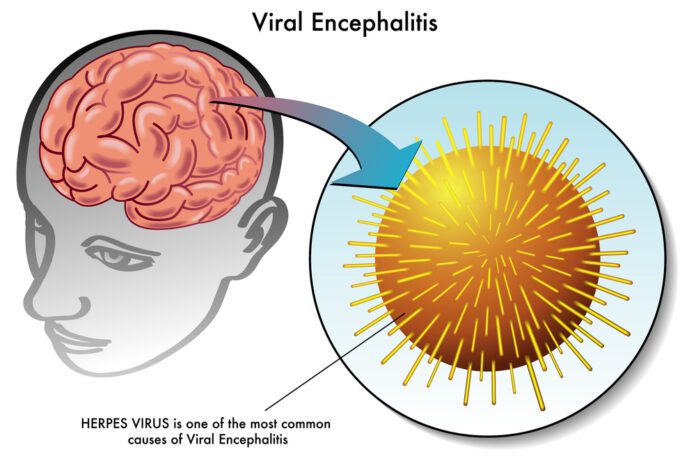Overview
Encephalitis is irritation and swelling (inflammation) of the brain, most often due to infections.
Cause
Encephalitis is a rare condition. It occurs more often in the first year of life and decreases with age. The very young and older adults are more likely to have a severe case.
Encephalitis is most often caused by a virus. Many types of viruses may cause it.
Exposure can occur through:
- Breathing in droplets from the nose, mouth, or throat from an infected person
- Contaminated food or drink
- Mosquito, tick, and other insect bites
- Skin contact
Different viruses occur in different locations. Many cases occur during a certain season.
Encephalitis caused by the herpes simplex virus is the leading cause of more severe cases in all ages, including newborns.
Routine vaccination has greatly reduced encephalitis due to some viruses, including:
- Measles
- Mumps
- Polio
- Rabies
- Rubella
- Varicella (chickenpox)
Other viruses that cause encephalitis include:
- Adenovirus
- Coxsackievirus
- Cytomegalovirus
- Eastern equine encephalitis virus
- Echovirus
- Japanese encephalitis, which occurs in Asia
- West Nile virus
After the virus enters the body, the brain tissue swells. This swelling may destroy nerve cells, and cause bleeding in the brain and brain damage.
Other causes of encephalitis may include:
- An allergic reaction to vaccinations
- Autoimmune disease
- Bacteria such as Lyme disease, syphilis, and tuberculosis
- Parasites such as roundworms, cysticercosis, and toxoplasmosis in people with HIV/AIDS and other people who have a weakened immune system
- The effects of cancer
Symptoms
Some people may have symptoms of a cold or stomach infection before encephalitis symptoms begin.
When this infection is not very severe, the symptoms may be similar to those of other illnesses:
- Fever that is not very high
- Mild headache
- Low energy and a poor appetite
Other symptoms include:
- Clumsiness, unsteady gait
- Confusion, disorientation
- Drowsiness
- Irritability or poor temper control
- Light sensitivity
- Stiff neck and back (sometimes)
- Vomiting
Symptoms in newborns and younger infants may not be as easy to recognize:
- Body stiffness
- Irritability and crying more often (these symptoms may get worse when the baby is picked up)
- Poor feeding
- A soft spot on the top of the head may bulge out more
- Vomiting
Emergency symptoms:
- Loss of consciousness, poor responsiveness, stupor, coma
- Muscle weakness or paralysis
- Seizures
- Severe headache
- Sudden change in mental functions, such as flat mood, impaired judgment, memory loss, or a lack of interest in daily activities
Treatment
The goals of treatment are to provide supportive care (rest, nutrition, fluids) to help the body fight the infection and to relieve symptoms.
Medicines may include:
- Antiviral medicines, if a virus caused the infection
- Antibiotics, if bacteria is the cause
- Antiseizure medicines to prevent seizures
- Steroids to reduce brain swelling
- Sedatives for irritability or restlessness
- Acetaminophen for fever and headache
If brain function is severely affected, physical therapy and speech therapy may be needed after the infection is controlled.
Exams and Tests
The health care provider will perform a physical exam and ask about symptoms.
Tests that may be done include:
- Brain MRI
- CT scan of the head
- Single-photon emission computed tomography (SPECT)
- Culture of cerebrospinal fluid (CSF), blood, or urine (however, this test is rarely useful)
- Electroencephalogram (EEG)
- Lumbar puncture and CSF examination
- Tests that detect antibodies to a virus (serology tests)
- Test that detects tiny amounts of virus DNA (polymerase chain reaction — PCR)
Source
Courtesy of MedlinePlus from the National Library of Medicine



